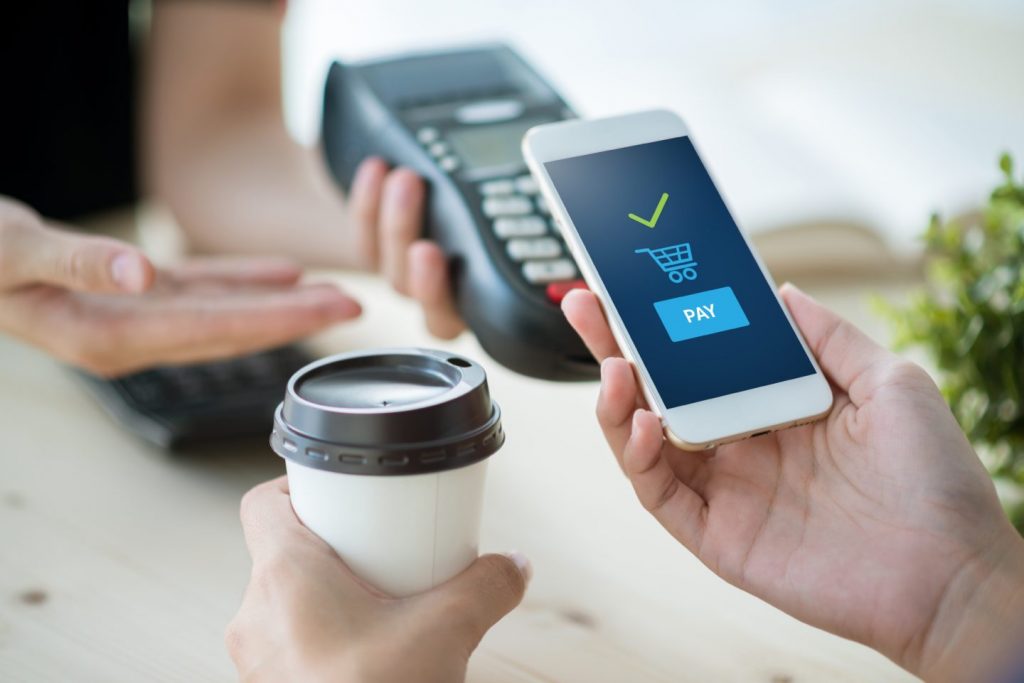Over the last few years, the payments industry has rapidly adapted to the patterns and trends of customers worldwide. One of the most prominent trends in the marketplace today, and one that continues to increase in both functionality and popularity, is that of mobile payments. People carry their phones with them everywhere they go, and it only makes sense to offer payment solutions that integrate with devices that are already highly practical and in the hands of the average consumer. Mobile payments can take a few different shapes, so we will break each of them down for you in the following sections.
NFC Contactless & Mobile Wallets
We recently touched base on the topic of NFC contactless payments in our blog article, but here’s a quick refresher. NFC (near field communication) technology uses RFID (radio-frequency identification) to transfer payment information between a customer’s device and your credit card terminal. In other words, radio waves use an encryption method to pass information between technologies to ensure the valuable information is moved securely. RFID technology isn’t new to the scene, however, but was invented by Charles Walton in 1983. We’ve been using RFID in bar codes to track inventory, in races to track runners’ race time, and even at conferences and events to track attendance. You may have interacted with RFID technology countless times in your lifetime but are just now aware that it’s been introduced to the payment’s scene as well.
Probably the most obvious method in which you’ll see NFC contactless come across your counter is through a mobile wallet where customers can upload their credit card information into their phone or smart watch and scan it during check-out without ever using their physical card. Customers can also use their virtual wallets to make payments within apps on their device, not just while checking out in a brick-and-mortar store. Popular mobile wallets you’ve probably seen are Apple Pay and Google Wallet. However, this new payment method is becoming so widespread that other brands such as Walmart, Kohls, Android and Microsoft have each released their own version.
Mobile Card Readers
Mobile payments have created new opportunities to bring your business on the go, so take advantage of it! Whether you own a restaurant and want to take payments table side or if you often visit trade shows, conventions, or markets with your goods, mobile card readers make taking payments easier no matter where you are. Not only that but think about your current ratio of card versus cash payments and realize that fewer consumers use or keep cash on hand anymore. People are searching for optimal convenience and gravitate toward the companies that value their customers enough to offer the latest technological solutions. Most mobile card readers plug into whatever device you have, whether a phone or tablet, and come with options to swipe, dip or key in credit card information. Having options that don’t require you to stand behind a counter and make customers come to a certain check out point will optimize your brand experience and count as a win for everyone involved.
Online Shopping
If your business model includes e-Commerce to any degree, having a seamless online shopping experience is key to retaining customer loyalty. Consumers are shopping on their phones more than on desktop these days, so it’s even more important to take stock of your mobile shopping user experience and make adjustments as needed to prevent losing sales. This includes everything from how information and content are displayed to the check-out process and how easy it is for customers to finish the required steps in order to complete the sale. If your content is stretched out and hard to read or your forms are pages long, customers will become frustrated and abandon their carts. Responsiveness is key to ensuring that all of your website content translates correctly across all devices, from desktop to mobile phone. Remember to keep it simple and minimize the amount of information you require at check-out, since an overload of information will exasperate the user. One last thing to think about is having an air-tight payment gateway that can keep up with the amount of online traffic you may experience and the speed your customers expect. With all of these things in check, your mobile shopping experience will be bar to none.
It’s important to note that the majority of online purchases come through apps these days, rather than mobile websites. Your business may not be ready to invest in the development of your own app, but it’s something to consider as you project future growth and ways to accommodate your loyal customers.
Mobile Invoicing
The final element we want to address is mobile invoicing. It may seem burdensome to take your company paperless with online invoicing and direct payments, but it will be worth your time and effort. Having the ability to make important business decisions on the go and pay vendors or contractors easily will free you to spend more time on tasks that you enjoy. There are countless tools for integrating mobile invoicing into your business model, so do some research and find the method that works best for you. Most of these platforms also allow you to track sales and keep an eye on important payment statuses which is a huge plus in our book.
Mobile payments are the future of our industry and an important pillar in the makeup of your company. Bring your business up to the 21st century by implementing mobile payments and you’ll make life easier for your customers, employees, and even yourself. If you’re unsure of how to get started and want to learn more, we’d love to help! Fill out the contact form below and one of our team members will be in touch shortly.

